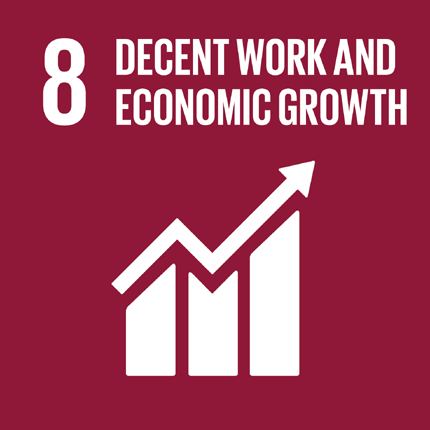sdg8
SUSTAINABLE DEVELOPMENT GOAL 8
Promote sustained, inclusive and sustainable economic growth, full and productive employment and decent work for all
Progress of goal 8
- Sustained and inclusive economic growth is necessary for achieving sustainable development. The global annual growth rate of real GDP per capita increased by 1.3 per cent in 2014, a significant slowdown compared to 2010 (2.8 per cent growth) and 2000 (3.0 per cent growth). Developing regions grew far faster than developed regions, with average annual growth rates in 2014 of 3.1 per cent and 1.4 per cent, respectively.
- Labour productivity (measured by GDP per worker) spurs economic growth. Growth in labour productivity in developing regions far outpaced that of developed regions, especially in Asia. Between 2010 and 2015, labour productivity grew by 0.9 per cent per year, on average, in developed regions, while rising by 6.7 per cent per year, on average, in Eastern Asia, the region with the fastest growth. Despite rapid growth in some developing regions, labour productivity remains far higher in the developed regions. In 2015, the average worker in developed regions produced 23 times the annual output of an average worker in sub-Saharan Africa (which has the lowest labour productivity in developing regions), and 2.5 times that of an average worker in Western Asia (which has the highest labour productivity in developing regions).
- The global unemployment rate stood at 6.1 per cent in 2015, down from a peak of 6.6 per cent in 2009, mostly owing to a decline in unemployment in the developed regions. Unemployment affects population groups differently. Globally, women and youth (aged 15 to 24) are more likely to face unemployment than men and adults aged 25 and over. In all regions, except Eastern Asia and the developed regions, the unemployment rate among women is higher than that of men. In almost all regions, the rate of youth unemployment is more than twice that of adults.
- Although the number of children engaged in child labour declined globally by one third from 2000 to 2012 (from 246 million to 168 million), more than half of child labourers in 2012 (85 million) were engaged in hazardous forms of work. The incidence of child labour was highest in sub-Saharan Africa, where 21 per cent of children were employed as child labourers. Of all child labourers worldwide, 59 per cent were engaged in agricultural activities in 2012.
- While economic growth and employment are important for economic security, access to financial services is an essential component of inclusive growth. Between 2011 and 2014, the proportion of the world’s adult population with an account at a financial institution or a mobile money service provider increased from 51 per cent to 62 per cent, meaning that 700 million adults became account holders during this period. Financial exclusion disproportionately affected women and the poor. The proportion of women who are account holders is 9 percentage points lower than the proportion of men who are account holders. Moreover, the proportion of account holders among the poorest 40 per cent of households is 14 percentage points lower than among those living in the richest 60 per cent of households.
- In 2014, aid for trade assistance was $54.8 billion, an increase of almost 120 per cent over the period from 2002 to 2005. However, total commitments fell slightly (by $1 billion) in 2014 compared to 2013, driven mainly by a $4.7 billion drop in support for transport and storage. A total of 146 developing countries received aid for trade assistance in 2014, with lower-middle-income countries receiving 39.4 per cent of the total, the least developed countries receiving 26.3 per cent and upper-middle-income countries receiving 19 per cent. On a per capita basis, however, the least developed countries received $10 per capita, more than any other income group and more than twice the global average.
Source: United Nations, Department of Economic and Social Affairs, SUSTAINABLE DEVELOPMENT KNOWLEDGE PLATFORM
The National Indicators for Sustainable Development Goal 8 are:
- Annual growth rate of real GDP per capita (%)
- Average hourly earnings of female and male employees, by occupation, age and persons with disabilities (in €)
- Unemployment rate, by sex, age and persons with disabilities (%)
- Proportion of youth (aged 15–24 years) not in education, employment or training (%)
- Real GDP per capita (in €)
- Investment share of GDP by institutional sectors (%)
- Young people neither in employment nor in education and training by sex (%)
- Long-term unemployment rate by sex (%)
- People killed in accidents at work (per 100 000 persons in employment)
- Inactive population due to caring responsibilities by sex (%)
All available data in .xls file:
- Decent work and economic growth
Last Updated: 9/5/2025
EU SDG indicator set
To measure SDG achievement in an EU context, an EU SDG indicator set was developed under the leadership of Eurostat. The purpose of this set, which is structured along the 17 global Sustainable Development Goals, is to monitor progress towards the SDGs at the European level.
- For the complete set of indicators available in the Eurostat database, click here.
- To compare Greece’s progress on specific indicators for each Sustainable Development Goal, click here [data visualisation].

